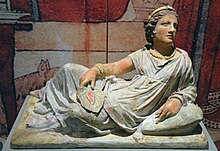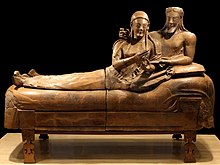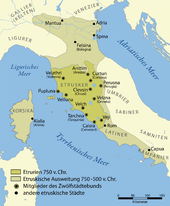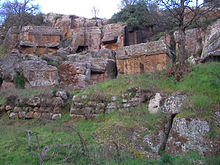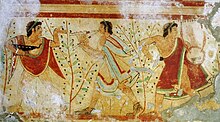Etruscan
The Etruscans ( Latin Etrusci , Tusci "Tusker"; ancient Greek Τυρσηνοί Tyrsenoi " Tyrsenians " Τυρρηνοί Tyrrhenoi "Tyrrhenians"), outdated and Etruscans were an ancient people of Etruria , which in northern central Italy in the area of today's regions Tuscany , Umbria and Latium lived and, according to Dionysius of Halicarnassus , called himself Rasenna .
The Etruscan culture is in this area between 800 BC. And the second half of the 1st century BC Demonstrable. After the Roman conquest (300 to 90 BC), the Etruscans were largely absorbed in the culture of the Roman Empire . But Prokop still reports in the 6th century AD about Etruscans among his contemporaries. With the study of Etruscan history, language and culture, the busy Etruscology .
The Villanova culture
Since around 1000 BC The Iron Age Villanova culture flourished in the area around Bologna and is best known for its cemeteries. The people who belonged to her cremated their dead and buried the ashes in tall urns, which often had a helmet-like lid. The urns were decorated with geometric motifs, there were also house urns that copied residential buildings. Typical grave goods were brooches and weapons. In the course of time this culture also spread to Tuscany. Strong changes can be observed from around 750 BC. Chr .: There were more and more necropolises , which suggests population growth. In the graves of this time there are more imports, especially from Greece; in addition, the graves were increasingly richly furnished, which indicates growing prosperity. Another notable change was the introduction of in-body burial, which displaced the urns. With these changes the culture of the Etruscans emerged, and their origins are hotly debated in research.
Theories of origin
The Etruscan culture probably only developed on the soil of Etruria . However, it is unclear whether the majority of the population immigrated immediately before this culture emerged. It has also not been possible to determine with certainty where the Etruscan language comes from. Two hypotheses have been put forward on these questions since ancient times.
Immigration theory
According to the immigration theory, the Etruscans came from Lydia ( Herodotus ) in Asia Minor and were after 1000 BC. Immigrated to what is now Tuscany. This scenario is supported by an obvious relationship between Etruscan and an inscription in Lemnian that was found on Lemnos and linguistically related to early Etruscan , as well as certain parallels to Lydian . The artistic development in the early first millennium in the orientalizing style also shows astonishing parallels to the Lydian area. A study of the genome of Tuscan cattle showed that they were once imported from Asia Minor.
Recent genetic research by the University of Turin provides further evidence that the Etruscans could have been settlers from ancient Lydia (Piazza et alii, 2007). According to Barbujani, the comparative investigations of the genetic material should have shown that a third of the mitochondrial alleles correspond to those of the Anatolian population and not the Italian. Furthermore, the investigation shows a homogeneous continuum of genes within the Etruscan population, both in geographical distribution and over time between the 7th and 2nd centuries BC. This is also more uniform than that of today's Italian or European population, which means that the Etruscans - at least as far as the upper social class is concerned - were not a mixture of peoples.
Autochthonous theory
The autochthonous theory, on the other hand, assumes that the Etruscan culture in central Italy developed from the Villanova culture . The Etruscan language is a pre-Indo-European language that had been isolated by the rather late immigration of the Indo-European tribes of the Italians into the Italian peninsula. The cultural and artistic flourishing of the Etruscans can be explained by the involvement of Tuscany in the flourishing trade in the Mediterranean area by Phoenicians and Greeks in the early 8th century BC. The use of the rich ore deposits accelerated economic and cultural development. This theory is supported by the seamless transition from the Villanova culture to the Etruscan culture, especially in the north, for example in Felsina (now Bologna ). At the turn of the ages, Dionysius of Halicarnassus advocated this theory.
synthesis
Today's Etruscology no longer asks about the origin of the Etruscans, but about their origins as a people. This is based on an ancient Mediterranean class that lived up to around 1000 BC. A settled peasant culture developed and into which foreign folk elements penetrated from both the east ( Phoenician seafarers) and from the north (Indo-European Italians). This is how the Villanova culture came into being. This population was overlaid by a very thin layer of immigrants from Asia Minor ( Tyrrhenians ). The Etruscan people developed from mixing with the local population.
history
overview
The first grave finds date from the 9th century BC. There are stone urn containers in Pozzo graves (small deepenings in the earth), which prove that the Protoetruscans originally used cremation. From the 8th century, the so-called fossa grave was created , a hollow in which the intact body was placed and which was closed with a plate. Around 750 BC The Etruscan maritime rule developed over the Tyrrhenian Sea. The development started primarily from the cities in southern Etruria. Around 600 BC The Etruscans had reached the height of their power. Together with the allied Carthaginians, they ruled the western Mediterranean and expanded both southwards into the area of today's Campania ( Salerno ) and northwards into the Po Valley (Bologna).
The cities were united in a loose league of cities ( Twelve Cities ), which was mainly religious, but less political. Religious center was at Orvieto or Bolsena located Fanum Voltumnae . There was no central Etruscan state. The Etruscans also ruled Rome (the name Roma is thought to be derived from an Etruscan family, the Rumlna, Latinized Romilii ). The form of rule in the cities was monarchical. In Latin transcription lucumo referred to the Etruscan king of a city. Otherwise, little is known about the internal conditions, even if many Etruscan elements were adopted by the Romans. These include, among other things, the purple tunic and the purple coat, the bundle of rods with ax ( fasces ) and the sign show (especially from the bird's eye view ). Most of the population probably lived in a highly dependent relationship with the nobility. The position of the woman, who was accorded a high degree of prestige, was exceptional.
Near the coast and in the south of Etruria, the most important centers of Etruscan culture were: Pupluna (Populonia) with the smelting of iron ore on the island of Elba , Tarquinia with the bronze processing, Caere (Cerveteri), which exploited the copper, iron and lead mines of the Tolfaberge , Vulci and finally Veji in the southern interior. In the north and inland, Cortona , Arezzo , Perugia , Chiusi and Volterra developed into important centers. Metal processing, ceramic production and probably also the production of agricultural products were predominant here. From a cultural point of view, despite various military conflicts, there was also a very fruitful exchange with the Greek world . So Etruscan art was influenced by Greek.
Since the 7th century BC There were efforts by the Etruscans to expand north and south. In the north they crossed the Apennines since the end of the 7th century and founded their own cities in the Po Valley. Especially between the years 550 to 520 BC. A strong Etruscanization began. The Villanova culture, which was previously widespread here, almost completely disappeared. However, due to the lack of direct written sources, the details of the processes are uncertain. At first there were more imports from Greece, which points to the establishment of a trade network. There are also Etruscan inscriptions from around 500 BC. BC, and the first cities were founded.
Carthage and the Etruscans defeated as allies of the Persians at the beginning of the Persian Wars in the sea battle of Alalia in 540 BC. In a joint action, Greek settlers from Phocia were able to cut off the Phoca colony of Massilia (today's Marseille ) by blocking the strait between Corsica and Elba from their connection to the Phoca colony of Elea . Probably not in the year 510 BC. BC (as the legend reports), but only some time later with the expulsion of the Tarquins from Rome the slow but steady decline of the Etruscans began. The defeat against a Greek fleet at the Battle of Kyme in 474 BC. Chr. Weakened the maritime rule of Etruria lastingly. Some time later, Etruscan rule collapsed in Campania as a result of the Samnite campaigns . Around 396 BC BC Veji was conquered and destroyed by Rome. A little later the Gauls overran the Etruscan region in the north; although they did not occupy it permanently, this also contributed to the weakening of the Etruscans. Until 265 BC BC, southern Etruria was conquered from Rome step by step. The cities in the north (Arezzo, Volterra, Perugia, Cortona) concluded alliance treaties with Rome and thus achieved a less dramatic assimilation into the Roman Empire. With the granting of the unrestricted Roman civil rights , it became in the year 90 BC. Chr. Also formally completed.
The rise of the Etruscan culture in the Roman Empire is symbolized by the person of Maecenas , who came from an old noble Etruscan family and was a confidante of the first Roman emperor Augustus . In the middle of the 3rd century AD, coins from the wife of the Roman emperor Trajanus Decius (ruled from 249 to 251) with the names of the empress Herennia Etruscilla and their son Herennius Etruscus referred to the descent from an ancient Etruscan family taken.
One of the last Roman connoisseurs of Etruscan culture and language was Emperor Claudius . Before he took office, which he never intended, he wrote a 20-book history of the Etruscans, following his antiquarian interests. The downfall of his main work is one of the particularly lamentable losses in tradition.
Timeline
- around 800 BC Chr .: Beginnings of the Etruscan culture and town building in Etruria
- around 750 BC Chr .: rise to sea power
- around 700 BC Chr .: Tumulus graves and grave paintings; rich grave goods
- around 600 BC Chr .: bronze art in oriental style, production of Bucchero ceramics
- 550 BC Chr .: Etrurian- Carthaginian coalition against Greece
- 540 BC Chr .: Sea victory at Alalia
- 524 BC Chr .: defeat at Kyme against the Greeks
- around 500 BC BC: flower of the Etruscan Capua
- around 500 BC BC: Overthrow of the Etruscan royal rule of Lucius Tarquinius Superbus in Rome, according to legend in 510 BC. Chr.
- 482 BC Chr .: Beginning of the dispute between Veji and Rome
- 474 BC Chr .: defeat of the Etruscans against Syracuse in the battle of Cumae (also Kyme)
- 430 BC BC: Defeat against the Samnites in Campania
- 406 BC BC: Siege of Veji by Rome
- 396 BC Chr .: Destruction of Veji by Rome
- from 396 BC Chr .: Incursion of the Celts into the Po Valley
- 384 BC Chr .: Dionysius I of Syracuse sacked Pyrgi ( Santa Severa )
- 358 BC BC: Alliance of Tarquinia and Cerveteri against Rome
- 310 BC Chr .: defeat against the Romans at Lake Vadimone
- 300 BC Chr .: Pyrgi becomes a Roman colony
- 280 BC Chr .: Defeat of Vulci against Rome
- 264 BC BC: Defeat of Volsinii against Rome
- 260 BC Chr .: Submission by the Gauls in the Po Valley
- 205 BC Chr .: Support Scipio in the campaign against Hannibal
- 183 BC BC: Foundation of the Roman colony in Saturnia
- 90 BC Chr .: Grant of Roman citizenship
- 82 BC Chr .: Repressions of Sulla in Etruria
- 79 BC Chr .: surrender of Volterra
- from 40 BC Chr .: Final Romanization of Etruria
Culture
The epochs of the Etruscan culture developed parallel to those of Greece and are evidence of intensive contacts in the Mediterranean area:
- Orientalizing art (800 to 650 BC): Parallels can be seen both with the Middle East ( Anatolia ) and with Carthage .
- Archaic Etruscan art (650 to 500 BC): strong influence of the Ionic and Corinthian cultures. A number of Greek artists and craftsmen can be traced in Etruria.
- Flowering period (500 to 300 BC): The Greek influence was very great, both in Classical and Hellenistic times. Art flourished despite the slow economic and political decline.
- Late period (300 to 100 BC): One can speak of a dialect of Hellenism . The Etruscan character merged with Hellenism.
Most of the art objects were excavated in the Etruscan necropolises ( Cerveteri , Tarquinia , Populonia , Orvieto , Vetulonia , Norchia ). Structural remains were rarely found; mostly it is only about the foundations of larger complexes. The most frequently represented group are the Etruscan temples , which have been systematically excavated since around 1870. Only recently have remains of secular architecture ( Murlo near Siena, Marzabotto near Bologna, Acquarossa near Viterbo, Talamone ) been scientifically excavated and evaluated.
The most important museums for Etruscan art objects are the Museo Nazionale Etrusco di Villa Giulia in Rome and the Archaeological Museum in Florence. The collections in Tarquinia, Chiusi, Orvieto, Arezzo, Volterra and Cortona are also important.
The famous Bucchero ceramic, which imitates metal vessels, was also from Etruscan production and was a widespread export.
religion
The religion of the Etruscans was also influenced by Greek tradition. Although this is - in contrast to all other pre-Christian religions of the West - a revealed religion is that deities were Greek influence anthropomorphized and rebelled, especially in the late period, a lot of the Greek Olympus on.
The Etrusca disciplina , the doctrine of the interpretation of divine signals and the correct handling of the world of gods, was famous in ancient times . Liver observation (Haruspician) and an interpretation of the flight of birds and lightning were just as much part of this teaching as the correct procedure for land surveying . These traditions were closely guarded by the Etruscan priesthood .
Voltumna was considered the supreme god of the Etruscans.
Writing and language
Only a few longer documents in Etruscan script have survived. The many grave inscriptions are very short and do not give any deeper insight into the language. Of the longer documents, the Agramer mummy bandage , which has been known since the 19th century and is exhibited in the Archaeological Museum in Zagreb , the clay tablet from Capua and the gold sheets from Pyrgi are to be mentioned.
The Etruscan script developed from an early Greek alphabet , is written from right to left and is easy to read. The language has not been fully deciphered because of the sparse material, but the existing texts can be translated, with some blurring. A vocabulary of around 150 words is currently known.
The relationship between Etruscan and other language groups is unclear.
Anatomical knowledge
A stone sculpture exhibited in the Louvre Museum in Paris , probably from the 3rd or 2nd century BC and assigned to the Etruscan culture, demonstrates special anatomical knowledge in detail . As a 68 cm high bust, it shows the torso of a young person, clothed except for the area that shows the front wall of the abdomen windowed below the thorax, with a view of the internal organs . The Louvre bought the bust in 2011 for a quarter of a million euros from the possession of a French doctor who had acquired it in 1960. The sculpture is said to come from the Canino excavation site northwest of Rome, the ancient Vulci , and was probably a votive offering .
Exhibitions
- 2017/2018: The Etruscans. World culture in ancient Italy , Badisches Landesmuseum Karlsruhe . Catalog.
- 2017/2018: Etruscans. Ancient high culture in the shadow of Rome, Museum zu Allerheiligen Schaffhausen. Catalog.
literature
- Luciana Aigner-Foresti : The Etruscans and early Rome. Scientific Book Society, Darmstadt 2003, ISBN 3-534-15495-9 .
- Luciana Aigner-Foresti, Peter Siewert (Hrsg.): Origin of state and city among the Etruscans. Problems and possibilities of researching early communities in Etruria in comparison to other Mediterranean cultures ( session reports of the philological-historical class. Volume 725). Austrian Academy of Sciences, Vienna 2006, ISBN 3-7001-3509-2 .
- Graeme Barker, Tom Rasmussen: The Etruscans , Blackwell, Malden (MA) / Oxford / Victoria 2000, ISBN 0631220380
- Bernard Andreae , Heinz Spielmann (ed.): The Etruscans. Exhibition catalog Hamburg. Hirmer, Munich 2004, ISBN 3-7774-2055-7 .
- Friederike Bubenheimer-Erhart: The Etruscans . Philipp von Zabern, Darmstadt 2014, ISBN 978-3-8053-4805-8
- Hans-Ulrich Cain , Hans-Peter Müller , Dirk Steuernagel (ed.): Renaissance of the Etruscans. From myth to science. Booklet accompanying a special exhibition at the Antikenmuseum der Universität Leipzig. Antikenmuseum der Universität Leipzig, Leipzig 2006.
- Giovannangelo Camporeale : The Etruscans. History and culture. Artemis & Winkler, Düsseldorf 2003, ISBN 3-7608-2300-9 .
- Mauro Cristofani (ed.): The Etruscans. Mysterious culture in ancient Italy. Belser, Stuttgart 2006, ISBN 3-7630-2270-8 .
- Franco Falchetti, Antonella Romualdi: The Etruscans. Theiss, Stuttgart 2001, ISBN 3-8062-1630-4 .
- Claus Hattler (ed.): The Etruscans. World culture in ancient Italy. Catalog for the exhibition in the Badisches Landesmuseum Karlsruhe from December 16, 2017 to January 1, 2018. Theiss, Darmstadt 2017, ISBN 978-3-8062-3621-7 .
- Sybille Haynes : Cultural history of the Etruscans. Zabern, Mainz 2005, ISBN 3-8053-3381-1 .
- Jean MacIntosh Turfa (Ed.): The Etruscan World. Routledge, London 2013, ISBN 978-0-415-67308-2 .
- Massimo Pallottino : Etruscology. Etruscan history and culture. Birkhäuser, Basel a. a. 1988, ISBN 3-7643-1874-0 .
- Ambros Josef Pfiffig : Introduction to Etruscology. 4th edition. Scientific Book Society, Darmstadt 1991, ISBN 3-534-06068-7 .
- Friedhelm Prayon : The Etruscans. CH Beck, Munich 1996, ISBN 3-8053-3619-5 .
- Friedhelm Prayon: The Etruscans. Concepts of the afterlife and ancestral cult ( Zabern's illustrated books on archeology ). Zabern, Mainz 2006, ISBN 3-8053-3619-5 .
- Christopher Smith : The Etruscans. Reclam 2016, ISBN 978-3-15-020403-0 .
- Maja Sprenger , Gilda Bartoloni: The Etruscans. Art and history . Hirmer, Munich 1976, ISBN 3-7774-2890-6 .
- Dorothea Steiner: Journey to the hereafter and underworld with the Etruscans. Research on iconography and meaning. Utz, Munich 2004, ISBN 3-8316-0404-5 .
- Stephan Steingräber : Ancient rock graves with special consideration of the Etruscan rock grave necropolis ( Zabern's illustrated books on archeology ). Zabern, Mainz 2015, ISBN 978-3-8053-4923-9 .
- Nancy Thomson de Grummond : Etruscan Myth. Sacred History and Legend. University Museum Publishing, Baltimore 2006, ISBN 1-931707-86-3 .
- Mario Torelli (Ed.): The Etruscans. Bompiani, Milan 2000, ISBN 978-88-452-4738-5 .
Web links
Remarks
- ↑ see Brockhaus Conversations-Lexikon, Volume 1, Amsterdam 1809, p. 395 .
- ↑ Dionysius of Halicarnassus: Ῥωμαϊκὴ ἀρχαιολογία ( Antiquitates Romanae ), 1.30 (English translation).
- ↑ a b Guido Barbujani: The Etruscans - a population genetic study. In: Günter Hauska (Ed.): Genes, languages and their evolution. Universitätsverlag, Regensburg 2005, ISBN 3-930480-46-8 , pp. 185 ff.
- ↑ Marco Pellecchia: The mystery of Etruscan origins - novel clues from Bos taurus mitochondrial DNA. In: Proceedings of the Royal Society of London B. No. 274, London 2007, doi: 10.1098 / rspb.2006.0258 , ISSN 0080-4649 , pp. 1175-1179.
- ↑ Origin of the Etruscans clarified. Gene comparison with result. Archived from the original on September 28, 2007 ; accessed on March 6, 2018 .
- ^ "Genetic tests: Italians were from Turkey. DNA of men whose forebears were probably Etruscans show they weren't local, but migrated, study says. " Los Angeles Times , June 2007
-
↑ C. Vernesi, D. Caramelli, I. Dupanloup, G. Bertorelle, M. Lari, E. Cappellini, J. Moggi-Cecchi, B. Chiarelli, L. Castrì, A. Casoli, F. Mallegni, C. Lalueza -Fox, G. Barbujani: The Etruscans: a population-genetic study. In: American Journal of Human Genetics . Volume 74, number 4, April 2004, pp. 694-704, doi : 10.1086 / 383284 , PMID 15015132 , PMC 1181945 (free full text). Quote:
- "The shortest genetic distances between the Etruscan and modern populations are with Tuscans (FST = 0.036; P = .0017) and Turks (FST = 0.037; P = .0001); [...]. The likely contributions of each parental population, or admixture coefficients, are similar for the three modern Italian populations, but Etruscans differ in two aspects: they show closer relationships both to North Africans and to Turks than any contemporary population. In particular, the Turkish component in their gene pool appears three times as large as in the other populations. [...] the similarity between the Etruscan and Turkish gene pools may indeed reflect some degree of gene flow. "
- ↑ Barker, Rasmussen: The Etruscans , 83-84
- ^ Graeme Barker, Tom Rasmussen: The Etruscans. Wiley-Blackwell, Oxford 1998, ISBN 0-631-22038-0 , p. 140
- ↑ a b Helmut Glück : Etruscan . In: Helmut Glück (Hrsg.): Metzler Lexikon Sprache . 3. Edition. JB Metzler, Stuttgart 2005, ISBN 3-476-02056-8 , pp. 182 , col. 1 .
- ↑ Spiegel online article Ancient statue shows human innards from September 1st, 2011


